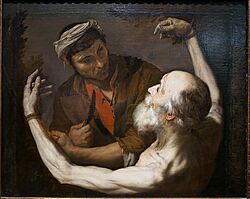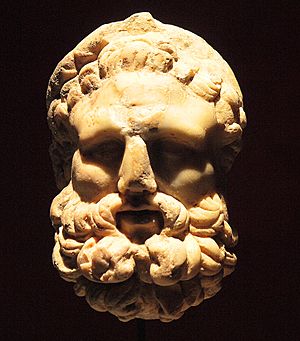Museo de Málaga facts for kids
The Museo de Málaga is a large and important museum located in Málaga, a city in Andalusia, Spain. It was created in 1973 by bringing together two older museums: the Provincial Museum of Fine Arts (which started in 1913) and the Provincial Archeological Museum (which began in 1947).
Even though they are now part of one big museum, the collections are still thought of as two main "sections." The Fine Arts section has over 2,000 artworks, while the Archeology section holds more than 15,000 ancient items. The museum officially opened its doors to the public in December 2016. It is now the biggest museum in the region of Andalusia and the fifth largest in all of Spain.
Exploring the Fine Arts Collection
The Fine Arts section of the museum has a long history. It began because of a special rule made on July 24, 1913. This rule encouraged the government to create art museums in cities that didn't have one yet. The Royal Academy of Fine Arts in Málaga had wanted such a museum for a long time.
The Provincial Museum of Fine Arts was officially started on February 3, 1915. It first opened to visitors in a temporary spot on August 17, 1916. Later, in 1920, it moved to a former Jesuit school building. In 1961, the collection moved again to the beautiful Buenavista Palace. However, it had to leave this palace in 1997. This happened because the government bought the palace to turn it into the famous Museo Picasso Málaga. After that, the Fine Arts collection was temporarily kept at the Palacio de la Aduana.
The museum proudly displays artworks by many famous artists. These include Luis de Morales, Luca Giordano, Bartolomé Esteban Murillo, Antonio del Castillo, Alonso Cano, Pedro de Mena, Jusepe de Ribera, Francisco de Zurbarán, Diego Velázquez, Francisco de Goya, Federico de Madrazo, Ramón Casas, José Moreno Carbonero, Enrique Simonet, Joaquín Sorolla, Léon Bonnat, Franz Marc and Pablo Picasso.
-
The martyrdom of Saint Bartholomew, around 1641.
(thought to be by Jusepe de Ribera)
Discovering the Archeological Collection
The Archeological section of the museum began in 1947. It brought together two important collections. One was from the old Museo Loringiano, which was based on a 19th-century collection owned by the Marquesses of Casa-Loring. The other part came from the archeological items that were already held by the Provincial Museum of Fine Arts.
These items from the Fine Arts museum came from digs that had been happening in the province since the 1930s. This included excavations at the Alcazaba of Málaga. The new Archeological Museum opened inside the Alcazaba in 1949.
In 1996, the Alcazaba needed repairs, so the collection had to move. It was temporarily kept in a 16th-century building called the Convento de la Trinidad until 1999. After that, it moved to a former historical archive building. This building is shared with the State Public Library. Before the main museum opened, some of these ancient treasures were shown in temporary exhibitions at the Palacio de la Aduana.
See also
 In Spanish: Museo de Málaga para niños
In Spanish: Museo de Málaga para niños
- List of museums in Málaga
- List of museums in Spain



